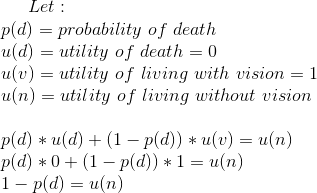All choices involve tradeoffs. Nowhere is this more evident than in the realm of medical decision making, where we sometimes face tradeoffs that require us to value a specific health outcome or capability.
For example, you might decide whether to start a course of treatment for low back pain that has some probability of alleviating your symptoms, but will be accompanied by potential side effects, such as weight gain or nausea. These are difficult tradeoffs, especially since we often have little prior experience to aid us in weighing each factor. While we often know our favorite foods — i.e., we know the relative utility of different options for situations we encounter frequently — we have trouble assigning utilities and making decisions about our desired health outcomes when we’ve never had to make such tradeoffs in the past.
Economists often assess individual utilities through a method called the standard gamble, which we can derive from expected utility theory. In a standard gamble, we present an individual with a simplified choice between (1) a known health state, such the continuation of low back pain, and (2) a treatment option that has some probability of a better outcome and a worse outcome. For simplicity, we often designate the treatment option as a probability of a permanent cure vs. a probability of guaranteed death.
Here’s an example from a recent experiment I ran: “Imagine that today you have been diagnosed with a disease that will lead to total vision blindness in both eyes with 100% certainty. There is a drug that you can take that will prevent your blindness with 100% certainty. However, the drug comes with a risk of immediate death. You can decide whether to take the drug. If you don’t take it, you will definitely lose your vision in the next month. If take it, you will not become blind, but there is some risk that you will immediately die. What is the largest risk of death that you would accept in order to take the drug?”
The logic is simple: the risk of death that you’d accept is equal to the utility of vision.

The standard gamble is a useful method to determine the utility of various health states and can aid individuals in making difficult decisions. Like all methods, the standard gamble suffers from several pitfalls, which we’ll explore in the future.